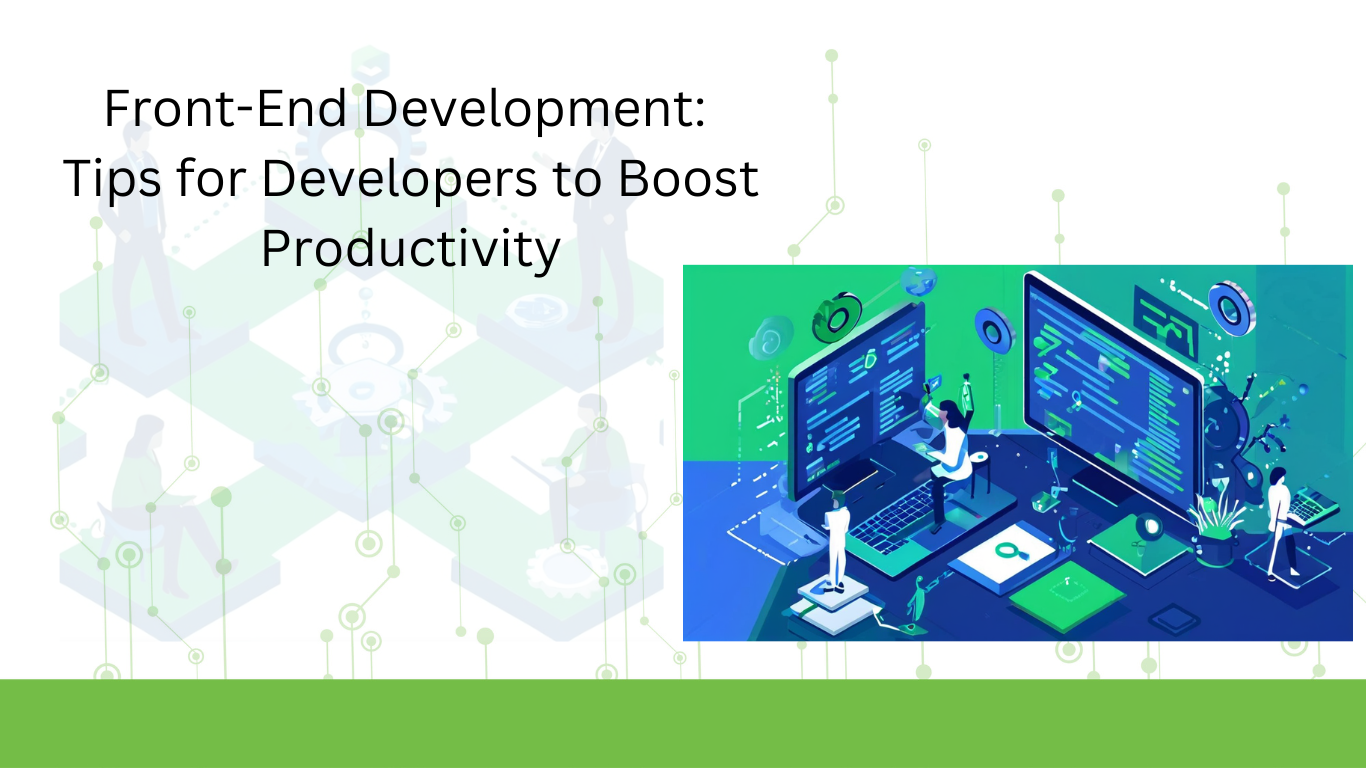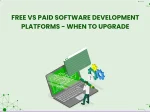Essential Tips and Tools for Modern Front-End Development
Since increasing numbers of apps are being developed day by day, the demand for front-end developers is also increasing continuously. But at the same time, the competition between innovators is also getting tougher. Therefore, it is so important to keep yourself updated with the new front-end development tools & methods. Not only does this assist you in working more effectively, but it also gives you an edge in the industry.

Working with a front-end JavaScript framework such as Ext JS can speed up your workflow & increase productivity on your projects.
Here in this guide, we will take you through advanced tips to enhance your development process & work more smartly.
The Basics of Front-End Development
It is all about building the part of an app that users see and interact with – also known as the client side. It involves creating and implementing the user interface (UI) so that the app appears good and runs efficiently. This includes tasks like:
- Choosing colors, fonts, icons & button styles.
- Designing forms & input fields for users to type or select information.
- Organizing how these elements are arranged on the screen so the app feels clean & easy to use.
To develop the interface of an application, developers must have knowledge of fundamental coding languages such as HTML, CSS & JavaScript. These are the building blocks of the codes used to develop what users actually see on a website or application. It’s also beneficial for programmers to have knowledge of such front-end development tools as Sass or Less, which facilitate CSS writing faster & more organized.
In the modern age, simply knowing the fundamentals is not sufficient. JavaScript libraries & frameworks like jQuery, React, Angular & Bootstrap are commonly used by developers. These make the AI tool for front end development process faster & enable the production of strong, responsive apps more effectively.
If you’re developing high-quality business web applications, mastering how to use front end development frameworks like Ext JS can make a huge impact. Ext JS is a JavaScript framework designed specifically for developing powerful, enterprise-level applications. But it’s also flexible enough to build any kind of user interface, whether basic or advanced. Ext JS is famous for:
- 140+ fully tested pre-built components
- Cross-browser and cross-platform compatibility
- Robust data management capabilities
- Out-of-the-box security features
Also Read: Enterprise Software Development Process: 6-Step Approach for Success.
Core Technologies & Programming Languages for Front-End Development
There are several important technologies and programming languages that form the foundation of creating all that you see & interact with on a site or app. These are all used together to develop the structure, style, and interactive features that allow a user’s experience to be fluid and engaging. Knowing these fundamentals is a must for anyone just starting out in front-end development tools or wanting to enhance their skills. Below are the most popular programming languages and technology used in front-end development:
HTML ( HyperText Markup Language)
It is the foundation of all web pages. It defines the basic structure and content, such as headings, paragraphs, images & links. When you visit a website, your browser analyzes code to understand what to display & how to organize everything on the page. Without HTML, we would have no way to build and show web pages, and it is an essential component of front end web development.
CSS (Cascading style sheets)
It is responsible for making an online presence look nice. It controls the color, fonts, spacing & overall layout of a web page. This allows you to style various sections of the page – such as the header, footer, buttons, and text, to create an attractive and user-friendly appearance. It helps plain HTML into a beautiful and well-structured site that users like to enjoy using.
JavaScript (JS)
It is the programming language that makes a website come alive. It provides interactive elements such as clickable buttons, sliding image galleries, drop-down menus & animations. All this is possible because of JavaScript, which enables web pages and applications to quickly react to what the user does, and hence, the experience is smooth and enjoyable. Without it, sites would be mostly static and less enjoyable to use .Watch this video to discover a powerful JavaScript framework that simplifies and accelerates modern web app development.
jQuery
It is a widely known JavaScript library that simplifies working with web pages. It allows you to easily search for and modify elements of a webpage, such as buttons or text, without having to write a lot of complex code. It also makes it easy to deal with events – such as clicks or keypresses and load data from servers in the background without a page refresh through its AJAX capabilities. This accelerates development and enhances user experience.
Front-end JavaScript Frameworks
JavaScript frameworks are tools that front-end developers use to develop interactive and visual user interfaces in less time. These front end development frameworks with pre-existing code & built-in functions for common tasks, meaning developers do not have to start from the beginning each time. This not only speeds up development but also makes it possible to develop consistent and reliable apps.
Some of the most popular web development frameworks include React, Ext JS & Angular. These are based on a component-based structure, which implies that developers can create reusable parts of the interface. The development becomes quicker & the code remains easier to manage and organize.
Top 9 Tips to Enhance Your Front-End Coding Efficiency
Here are expert tips to increase your productivity. Taking advice from experienced developers can provide you with real-world ideas on how to work smarter, not harder. These focus on everything from enhancing your coding skills & practicing improved techniques to streamlining your workflow and selecting proper front end developer tools. By implementing them, you can speed up your projects and deliver better results with less effort.
1. Stay Updated with the Latest
One of the most essential tasks is to keep up-to-date with the latest frameworks. These are continuously evolving with the latest tools and features that make development easier. While discovering the most popular front end frameworks, it is also important to select the appropriate one for your requirements. Once you identify the perfect, you can increase your productivity by using them easily.
Additionally, it is also valuable to keep informed about the progress in coding languages used for web front end framework. You can visit many online resources, forums, and front-end development communities to remain updated.
2. Plan and Organize Projects
The first process in creating the project is to organize and plan the process. This will include determining the requirements of the project, setting goals, and establishing desired objectives.
It is also beneficial to define a clear specification of the project’s functionality. This will avoid rework. You can also use project management tools & follow software development methodologies like “Agile” or “Scrum” to effectively plan your tasks.
3. Utilize Component-based Development
Today, developers use the well-known method of component-based development. It simply means dividing your application into components that are manageable and reusable. This method really boosts app performance & productivity among them.
By modularizing your code, you can reuse these units in different contexts. This encourages collaboration among teams & enhances the maintainability and scalability of your code. The best front-end framework for wordpress provides this feature. It enables you to develop efficient component-based codes in projects. Discover how to efficiently manage multiple projects with ease using Rapid Ext JS by watching thi video.
4. Optimize Code and Performance
To enhance productivity, efficient code plays a vital role. Optimized code not only improves performance but also facilitates easier debugging & maintenance.
So, always keep in mind that your code is performing optimally by using good coding techniques. Such practices involve removing redundant dependencies, reducing the size of the file & modularizing the code. All these make the loading of the site faster, give a better user experience, and improve the search engine ranking.
Furthermore, using performance monitoring tools such as Google PageSpeed Insights, Lighthouse & Browser Developer Tools can assist in identifying points and optimizing key aspects of your app.
5. Use Automation & Task Runners
Increasing efficiency in front-end development can be significantly realized through automation. Using widely used task runners like Grunt or Gulp, you can effectively determine repetitive tasks in your workflow.
These tools let you automate processes such as code compilation, image optimization & deployment. This saves a lot of time and effort. Streamlining your workflow helps you focus on other key areas and speed up project completion.
6. Embrace Collaboration and Version Control
Teamwork and version control are needed in web programming frameworks. You can control changes to code, monitor revisions, and collaborate with team members effectively by adopting collaborative tools and systems such as Git.
For ensuring the quality of code & encouraging cooperation, documentation, and code reviews are also necessary. You can get feedback from different perspectives from other people and identify potential issues early on. This boosts productivity and produces quality code.
7. Continuously Learn and Improve Skills
In order to stay updated and improve productivity, you need to practice. Get into the habit of checking blogs, whitepapers & documentation of reputable sites such as Sencha. Explore online education sites and platforms, including Coursera & Codecademy, to further enhance your.
Also, engage actively in workshops, conferences, webinars & developers’ communities. This will expose you to other professionals in your field and gain valuable information.
8. Prioritize Testing and Debugging
Testing and debugging are crucial when creating high-quality front-end applications. Give unit testing, integration testing & user acceptance testing at all stages of the development process. In addition, try to include testing frameworks such as Jest or Mocha within your codebase. These assist in ensuring that your application behaves as expected.
By employing correct methods and front-end development tools, productivity is also maximized. In solving issues and optimizing your code, effective debugging practices will save you from wasting time and getting frustrated.
9. Practice Efficient Time Management
Productivity improvement requires effective time management. Use of time management techniques such as the Pomodoro Technique. It involves working in focus sprints & taking regular breaks in between to stay focused and productive.
To assess your time management skills & improvement, use time-tracking tools. Prioritize tasks, create realistic timelines & avoid external distractions to stay focused. With proper time management, you can improve productivity, deliver project deadlines & maintain a good work-life balance.
Why Sencha Ext JS Is a Top Framework?
Sencha Ext JS is one of the open source front end css/html frameworks for development. It provides developers with a powerful toolkit to create engaging and feature-packed web applications. With its extensive library of pre-packaged elements, It streamlines the process of developing complicated user interfaces. This increases productivity and allows you to concentrate on creating awesome apps without the need to begin from the beginning.
How Ext JS Enhances Front-End Developer Productivity
Ext JS is a highly recommended framework for front-end developers since it provides a bunch of useful features to enhance productivity. These include:
Comprehensive Component Library
A wide variety of UI components, from buttons to complex grids and charts, are available in the extensive component library. Developers can use these pre-build elements to increase their coding efficiency and create stunning UIs.
MVC Architecture
Ext JS supports code modularity by adhering to the Model-View-Controller (MVC) architecture. This facilitates developer collaboration, streamlines development & enhances code maintainability.
Powerful Data Binding
Ext JS’s powerful data binding capabilities make data manipulation and synchronization simple. Data from different sources can be bound to UI components, guaranteeing real-time updates.
Built-in UI Theming
Ext JS’s built-in UI theming features enable developers to quickly alter the appearance, look, and feel of their apps. Without requiring a lot of manual styling, this feature makes it possible to maintain branding and create visually appealing UIs.
Cross-Browser Compatibility
Ext JS makes sure that applications are cross-browser compatible. It ensures the smooth functioning of apps across various web browsers. Without having to worry about problems or inconsistencies with particular browsers, developers can concentrate on creating functionalities.
Documentation and Support
Sencha provides extensive documentation & support for Ext JS, including in-depth tutorials, API references, and working examples. This enables developers to quickly acquire knowledge and improve their efficiency in their work.
Integrated Tooling
The productivity of front-end developers is significantly increased by the integrated tooling in Ext JS. It offers a range of built-in tools, such as:
- Integrated code editors and IDEs
- A command-line interface (CLI), an inspector
- A debugger
- Sencha Themer for custom styling.
Additionally, Ext JS provides build and optimization tools, as well as seamless integration with testing frameworks. These tools enhance collaboration, automate repetitive tasks, streamline development processes, and simplify debugging.
Check Ext JS Client Review/ Case Study (Icube)
Ext JS’s use at Icube is a prime example of how it has enhanced productivity. Specifically, Icube developed a highly intuitive payment platform called MilkPay using the Ext JS framework and its user-friendly UI components.
With Ext JS, Icube successfully automated every step of the transaction process for nearby cheese factories and milk producers, leading to increased productivity and efficiency. For further insights into Icube’s utilization of Ext JS, you can explore their case study available here.
Conclusion
To increase your front-end development efficiency, it’s all about following expert advice. In this post, we’re provided valuable tips for developers. One great example is using front-end development tools such as Ext JS, which can significantly accelerate your work and make you more efficient.
Ext JS provides a large library of pre-built UI components, a good MVC framework, powerful data binding, an in-built theming option, support for multiple browsers & detailed documentation – all designed to enable you to develop apps quicker and simpler.
FAQs
What are the back end and front end?
Front end refers to what users visually see & work with on a website or application, such as buttons, menus, and pages. The back end refers to the part that goes on behind the scenes to work with data, servers & the programming logic that makes it all happen.
How to become a front end web developer?
Start by learning the basics – HTML, CSS & JavaScript. Practice building simple websites, then move on to frameworks like React or Ext JS. Keep learning, work on projects & join developer communities to improve your skills.
Which of the following best describes a front-end developer?
It creates the parts of a site or applications that users interact with, making sure it looks good & works smoothly.
Which front-end framework is best for Python?
Python itself is primarily a back-end language, but for front development, you would use frameworks such as React or Vue.js. These can be interfaced with Python frameworks such as Django or Flask.
What are front-end UI frameworks?
These are pre-made collections of components and technologies that make it easier and faster for developers to design and produce interfaces for users.
What are some popular front-end frameworks?
The most popular are React, Angular & Vue.js. But Ext JS is great for its robust features & simplicity in creating complex, user-friendly applications. They make the developer’s task easier in building smooth & interactive websites.
What is the backend vs front end in simple terms?
The front end is everything you see and click on a website or app, like buttons and images. The backend is the system behind the scenes that stores data and makes sure everything works properly.
Don’t wait – start your journey to smarter, faster development now.

The selection of a front end framework for enterprise applications remains one of the most…

Every software project begins with a choice that reverberates through its entire lifecycle: which development…

Building software for regulated industries demands more than functional code. Healthcare organizations must protect patient…









